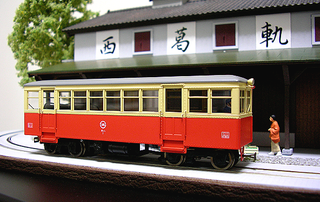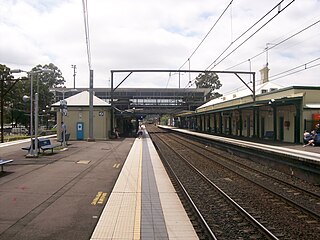Depot may refer to:
Depot may refer to:

Railway modelling or model railroading is a hobby in which rail transport systems are modelled at a reduced scale.

A typeface is a design of letters, numbers and other symbols, to be used in printing or for electronic display. Most typefaces include variations in size, weight, slope, width, and so on. Each of these variations of the typeface is a font.
In typography, leading is the space between adjacent lines of type; the exact definition varies.

Yeovil Junction railway station is the busier, but less central, of two railway stations serving the town of Yeovil in England. The station is 2 miles (3.2 km) outside the town, in the village of Stoford. Although Yeovil is in Somerset, the station was in Dorset until 1991. It is 122 miles 48 chains (197.3 km) down the line from London Waterloo.

In railroad structures, and rail terminology, a wye or triangular junction is a triangular joining arrangement of three rail lines with a railroad switch at each corner connecting to the incoming lines. A turning wye is a specific case.
In digital typography, Lucida Sans Unicode OpenType font from the design studio of Bigelow & Holmes is designed to support the most commonly used characters defined in version 1.0 of the Unicode standard. It is a sans-serif variant of the Lucida font family and supports Latin, Greek, Cyrillic and Hebrew scripts, as well as all the letters used in the International Phonetic Alphabet.

LocoScript is a word processing software package created by Locomotive Software and first released with the Amstrad PCW, a personal computer launched in 1985. Early versions of LocoScript were noted for combining a wide range of facilities with outstanding ease of use. This and the low price of the hardware made it one of the best-selling word processors of the late 1980s. Four major versions of LocoScript were published for the PCW, and two for IBM-compatible PCs running MS-DOS. LocoScript's market share didn't expand with the PC versions, which were not released until after Windows had become the dominant PC operating system.

Johnston is a sans-serif typeface designed by and named after Edward Johnston. The typeface was commissioned in 1913 by Frank Pick, commercial manager of the Underground Electric Railways Company of London, as part of his plan to strengthen the company's corporate identity. Johnston was originally created for printing, but it rapidly became used for the enamel station signs of the Underground system as well.

A motive power depot (MPD) or locomotive depot, or traction maintenance depot (TMD), is where locomotives are usually housed, repaired and maintained. They were originally known as "running sheds", "engine sheds" or just "sheds". Facilities are provided for refuelling and the replenishing of water, lubricating oil and grease and, for steam engines, the disposal of ash. There are often workshops for day-to-day repairs and maintenance, but locomotive building and major overhauls are usually carried out at locomotive works.
In typesetting and page layout, alignment or range is the setting of text flow or image placement relative to a page, column (measure), table cell, or tab.

Penrith railway station is a heritage-listed railway station located on the Main Western line in the western Sydney suburb of Penrith in the City of Penrith local government area of New South Wales, Australia. It was designed by New South Wales Government Railways and the 1863 building was built by M. and A. Jamison and D. Forest. It is also known as Penrith Railway Station group. The property was added to the New South Wales State Heritage Register on 2 April 1999.

Ōtāhuhu railway station is located on the Eastern and Southern Lines of the Auckland rail network in New Zealand. It has an island platform configuration and is part of an integrated bus-train major transport hub. It can be reached by steps and lift from an overhead concourse that leads from the adjacent bus transfer station and Walmsley Road.
The railways in Germany use several abbreviations to differentiate between various types of stations, stops, railway facilities and other places of rail service.

Hof Hauptbahnhof is the main railway station in Hof in southern Germany and is situated at the intersection of the Saxon-Franconian trunk line (Magistrale) and the Munich–Regensburg–Leipzig–Berlin line. When it was opened it formed the boundary between the former Bavarian Ludwig South-North Railway Lindau–Hof to the Saxon-Bavarian Railway on the Saxon side from Hof–Leipzig.

Junee railway station is a heritage-listed railway station located on the Main South line in New South Wales, Australia. It serves the town of Junee in the Junee Shire. It was added to the New South Wales State Heritage Register on 2 April 1999.

Catanzaro Lido railway station is one of the railway stations serving the city and comune of Catanzaro, capital of the Calabria region, southern Italy. Opened in 1875, it forms part of the Jonica railway, and is also a terminus of a secondary line, the Lamezia Terme–Catanzaro Lido railway.

Meiningen station is a junction of four railways and with its facilities is one of the most important railway stations in southern Thuringia, Germany.

Optical margin alignment outdents letters like A, V, W, Y, and punctuation into the margins to align the text border optically. Some users remark that it makes the text margin look crooked, but this is because text frames or margin guides are visible. If text frames are not visible, e.g. in print preview, or when printed, the edge of a block of text looks more even if optical margin alignment is enabled.

Halberstadt station is a station on the Magdeburg–Thale railway in Halberstadt in the German state of Saxony-Anhalt. A terminal station was opened in the town in 1843. A new through station was opened in another part of the town in 1868. The first service from Halberstadt ran to Magdeburg. Two more lines were added during the next few decades. In the Second World War, the station suffered heavy damage. Extensive modernisation work took place between 2008 and 2010. The entrance building and the locomotive depot are listed buildings.

Franzensfeste station is a railway station located on the Brenner Railway and the western terminus of the Puster Valley Railway. It serves the town of Franzensfeste (Fortezza).